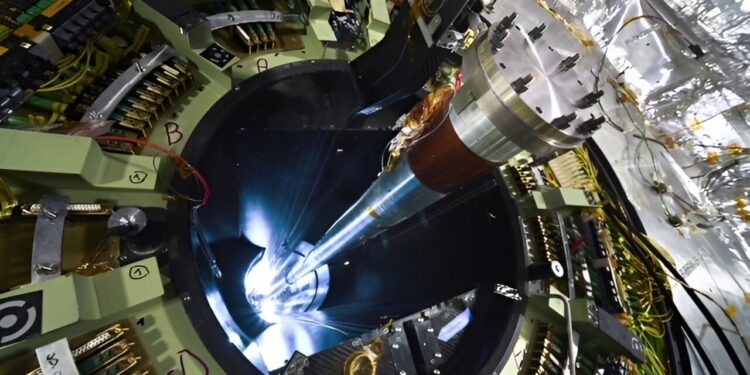Credit: University of Nottingham
New research using a decommissioned section of the beam tube at the Large Hadron Collider (LHC) at CERN has brought scientists closer than ever to testing the existence of magnetic monopoles.
Scientists from the University of Nottingham, working with an international team, have revealed the tightest constraints yet on the existence of magnetic monopoles, pushing the boundaries of what is known about these elusive particles. Their research has been published in Physical Exam Letters.
In particle physics, a magnetic monopole is a hypothetical elementary particle that is an isolated magnet with only one magnetic pole (a north pole without a south pole or vice versa).
Oliver Gould, Dorothy Hodgkin Fellow at the University of Nottingham’s School of Physics and Astronomy, is the lead theorist on the study. He said: “Could there be particles with only one magnetic pole, north or south? This intriguing possibility, championed by the renowned physicists Pierre Curie, Paul Dirac and Joseph Polchinski, has remained one of the most enthralling mysteries in theoretical physics. Confirming their existence would be transformative for physics, but so far experimental searches have come to nothing.”
The team focused its research on a decommissioned section of the LHC beam pipe at CERN, the European Organization for Nuclear Research.
Led by physicists from the LHC’s Monopole and Exotics Detector (MoEDAL) experiment, the study examined a section of beryllium beam pipe that had been placed at the particle collision point for the Compact Muon Solenoid (CMS) experiment. This pipe had been exposed to the radiation of billions of very high-energy ion collisions occurring just centimetres away.
“The proximity of the beam pipe to the collision point of ultrarelativistic heavy ions provides a unique opportunity to probe monopoles with unprecedentedly high magnetic charges,” explained Aditya Upreti, a PhD student who led the experimental analysis while working in Professor Ostrovskiy’s MoEDAL group at the University of Alabama.
“Because the magnetic charge is conserved, the monopoles cannot decay and should be trapped by the tube material, allowing us to reliably search for them with a device directly sensitive to the magnetic charge.”
The researchers studied the production of magnetic monopoles during heavy ion collisions at the LHC, which generate magnetic fields even stronger than those of rapidly rotating neutron stars. Such intense fields could lead to the spontaneous creation of magnetic monopoles through the Schwinger mechanism.
Oliver added: “Although this is an old piece of pipe destined for disposal, our predictions indicated that this could be the most promising place on Earth to find a magnetic monopole.”
The MoEDAL collaboration used a superconducting magnetometer to scan the beam pipe for signatures of trapped magnetic charges. Although they found no evidence of magnetic monopoles, their results rule out the existence of monopoles lighter than 80 GeV/c.2 (where c is the speed of light) and provide the peak constraints for magnetic charges ranging from two to 45 base units.
The research team is now considering expanding their search. Oliver concludes: “The beam tube we used comes from the first Large Hadron Collider experiment, which was performed before 2013 and at lower energies. By extending the study to a more recent experiment at higher energies, we could double our experimental scope. We are also considering completely different search strategies for magnetic monopoles.”
More information:
B. Acharya et al., MoEDAL search in CMS beam tube for magnetic monopoles produced via Schwinger effect, Physical Exam Letters (2024). DOI: 10.1103/PhysRevLett.133.071803
Provided by the University of Nottingham
Quote:Large Hadron Collider Brings Search for Elusive Magnetic Monopole Closer Than Ever (August 16, 2024) Retrieved August 16, 2024, from
This document is subject to copyright. Apart from any fair dealing for the purpose of private study or research, no part may be reproduced without written permission. The content is provided for informational purposes only.



